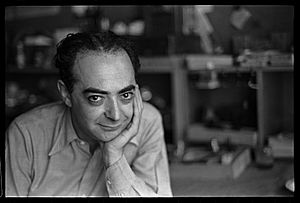Brassaï facts for kids
Quick facts for kids
Brassaï (Gyula Halász)
|
|
|---|---|

Self-portrait
|
|
| Born |
Gyula Halász
9 September 1899 |
| Died | 8 July 1984 (aged 84) Beaulieu-sur-Mer, France
|
| Nationality | Hungarian/French |
| Alma mater | Hungarian Academy of Fine Arts |
| Occupation | Photographer, writer, sculptor and painter |
| Spouse(s) | Gilberte-Mercédès Boyer |
Brassaï (born Gyula Halász; 9 September 1899 – 8 July 1984) was a famous Hungarian-French artist. He was a photographer, sculptor, writer, and filmmaker. He became very well known in France in the 20th century. Brassaï was one of many Hungarian artists who became successful in Paris between the two World Wars.
Contents
Early Life and School
Gyula Halász, who later used the name Brassaï, was born on 9 September 1899. His birthplace was Brassó, which was then part of the Kingdom of Hungary. Today, this city is called Brașov and is in Romania. His mother was Armenian and his father was Hungarian. He grew up speaking both Hungarian and Romanian. When he was three years old, his family lived in Paris for a year. His father, a professor of French literature, taught at the Sorbonne.
As a young man, Halász studied painting and sculpture. He went to the Hungarian Academy of Fine Arts in Budapest. He also joined a cavalry group in the Austro-Hungarian army. He served there until the end of the First World War. He said that the artist Henri de Toulouse-Lautrec was a big influence on his art.
Becoming a Famous Artist
After World War I, his hometown of Brassó became part of Romania. This happened because of the Treaty of Trianon. In 1920, Halász moved to Berlin. There, he worked as a journalist for Hungarian newspapers. He also started studying at the Berlin Academy of Fine Arts. He became friends with older Hungarian artists and writers there. Many of them later moved to Paris.
In 1924, Halász moved to Paris, France. He stayed there for the rest of his life. He learned French by reading books by Marcel Proust. He lived in the Montparnasse area, where many young artists gathered. He worked as a journalist. He soon became friends with American writer Henry Miller and French writers Léon-Paul Fargue and Jacques Prévert.
Halász's job and his love for Paris led him to photography. He often walked the city streets late at night. He first used photos to add to his articles and earn more money. Soon, he started exploring the city mainly through photography. Another Hungarian photographer, André Kertész, helped him learn. Brassaï later wrote that he used photography "to capture the beauty of streets and gardens in the rain and fog, and to capture Paris by night." He started using the name "Brassaï," which means "from Brasso," his birthplace.
Brassaï captured the true feeling of Paris in his photos. His first collection was published in 1933. It was a book called Paris de nuit (Paris by Night). The book was very successful. Henry Miller even called him "the eye of Paris." Brassaï took pictures of the city's nightlife. He also photographed the lives of high society people, thinkers, ballet dancers, and grand operas. A French family helped him meet people from the upper classes. Brassaï photographed many of his artist friends. These included Salvador Dalí, Pablo Picasso, Henri Matisse, and Alberto Giacometti. He also photographed famous writers like Jean Genet.
More young Hungarian artists came to Paris in the 1930s. Brassaï became friends with many of them. He also continued to work for money. He took photos for the American magazine Harper's Bazaar. He was also a founder of the Rapho agency, a photo agency started in Paris in 1933.
Brassaï's photographs made him famous around the world. In 1948, he had his own show at the Museum of Modern Art (MoMA) in New York City. This show then traveled to other places. MoMA showed more of Brassaï's work in 1953, 1956, and 1968. In 1979, Brassaï was added to the International Photography Hall of Fame and Museum.
Marriage and Later Life
In 1948, Brassaï married Gilberte Boyer, a French woman. She helped him with his photography work. In 1949, he became a French citizen. Before that, he had no official country.
Death
Brassaï passed away on 8 July 1984. He was 84 years old. He died at his home near Nice, on the French Riviera.
Books by Brassaï
- Paris de Nuit (Paris by Night). Paris: Arts et Métiers Graphiques, 1933.
- Conversations avec Picasso. Paris: Gallimard, 1964. This book shares his memories of talking with Picasso.
- Henry Miller: The Paris Years. Arcade Publishing, 1975.
- The Secret Paris of the 30s. New York: Thames & Hudson, 1976.
- Letters to My Parents. Chicago, IL: University of Chicago, 1997.
Where His Art Is Kept
Brassaï's work can be seen in many public art collections:
- Art Institute of Chicago, Chicago, IL
- Museum of Modern Art, New York City
- Rijksmuseum, Amsterdam
- Tate, London
- Victoria and Albert Museum, London
See also
 In Spanish: Brassaï para niños
In Spanish: Brassaï para niños


